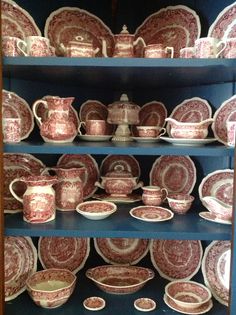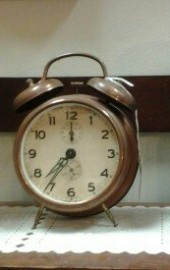There’s a poor behemoth Victrola VV-XIV tightly wedged between a long metal filing cabinet and a tiny portion of bookshelf space in a used furniture store. I promised myself, “no more” in regards to restoring these beautiful wind-up antique phonographs simply because the cost to restore them can outweigh the price you pay for the machine.
And it was only twice I seen a gold-plated Victrola model. The last one I had seen at a thrift store was beat to heck and back. There was rust all over it and it reeked of stagnant mold damage like it had been dredged up from the depths of a leaky basement– or worse, perhaps. And the thirft store was charging $368! There were 78s adhered to the storage shelves. It was a pitiful mess of Tetanus waiting to happen. And that baby upright Victrola didn’t stay in the thrift store very long. Don’t know if it was ever bought or sold, or made its way to the landfill.
But this large upright gold-plated Victrola was in far better condition. The cabinet was clean (although dusty), and it requires some major and minor TLC. It’s a labor of love I’d happily accept.
And this Victrola’s provenance (history of its previous owners and what state it came from) is completely N/A (non-applicable). This Victrola didn’t come with any paperwork and that’s to be expected. There was no instruction booklet (sometimes these do surface).
I have no clue who owned this antique talking machine, but it likely dates around Aug. 1, 1913 (checked the sticker on the back at the lower left hand corner). And I did some cross-reference from this fantastic site: The Victor Victrola page before I decided to return to the store.
This talking machine has been around a day or two. Sure the cabinet has a few nicks, a minuscule white paint speck here and there. Overall the ornate carved moldings are present and appear to be in good condition for their age. And nope, it’s not even close to being museum quality or even pristine condition. Most antique phonograph collectors with disposable incomes won’t even consider these less glossy talking machines or rather, let me say, cosmetically-challenged Victrolas that have veneer loss and/ or alligator-like cabinets due to separation of the original gloss. The stain appears to be red mahogany or something similar. And my Christmas present finally arrived yesterday morning.
I had the sales person give me an in-store demonstration long before I ever decided to get this particular Victrola. I cringed when I heard “At the Pawn Shop” by Guy Mitchell. I have nothing against this artist. For the love of Nipper, (Victrola’s mascot Fox Terrier), don’t ever play a 1950s 78 on a Victrola—ever. I stress this because the record grooves are different and can’t handle the heavy weight of a talking machine’s reproducer nor that of the steel needle that will act like a pumice stone thus causing groove walls of the 78 terrible wear and tear. Plus its very damaging to the mica diaphragm and creates an unpleasant shrill to the ears. Also, 78s recorded on or after 1935 is the cut-off point due to differences in the recording/cutting processes.
And I will always have Guy Mitchell’s song stuck in my head from now on whenever I lay eyes on this once proud, stunning glorious talking machine that was one of two flagship models in the Victor-Victrola line. It was $200 brand new back in 1913 or thereabouts. It is well over $4,000 in today’s money according to the Federal Reserve inflation calculator.
And it’s going to need critical TLC. As I suspected (and scrunched my shoulders when listening to it play in the store), the mainspring(s) were broke, possibly. They weren’t thumping per se, one—perhaps all three mainsprings are possibly weak which is very common on nearly all un-restored Victrolas nowadays if not well cared for by its former owner(s). I suspected such and figured up additional costs it’s going to take to get this beautiful talking machine to perform as it once did.
Three red flags went up in my mind aside from the common potential mainspring breakage, the internal horn shifted inside the cabinet. Also, there was scoring to the main board bolts likely due to someone using the wrong type of screw driver. And its missing four tiny gold-plated screws from its lid, which indicates to me the lid had been removed at some point.
Regardless, I’m happy with the new Victrola. It came with its own record duster (not often found with these machines), three packs of old original needles, and the cabinet key that’s original to the machine as well. The folks in the furniture store told me that a man tried to walk off with the cabinet key. This is because they are extremely hard to come by, very pricey when found, and seldom if ever, are retained with the phonograph.
I don’t plan to get into a massive rush to get the mainsprings repaired nor do will I have the Exhibition reproducer overhauled anytime soon. I decided to take the leisurely (or lazy approach) with this machine. The talking machine plays, but the mainsprings violently protest while it plays a 78 and sounds like one of the springs is uncoiling inside the barrel. And no, it’s not the ever common “thump,” “thump”, “thump” from dried grease in the mainspring barrels, its more than likely broken. I know since I own and serviced my own talking machines in my younger days and can detect by listening if its going to be something major that will require professional assistance or something minor like dried grease in the mainsprings.
I froze outside yesterday without a coat on so I could clean the caked on grease from the governor and worm drive shaft. And I remembered to put a few generous drops of Hoppie’s oil in the bushing and tips before I re-assembled it. That’s the extent of my main board adventure. There’s a few things I didn’t mess with simply because the majority of it calls for a professional, something of which, I’m not.
The cabinet was cleaned using Murphy’s Oil Soap and a clean cloth and cotton balls for the more intricate wood carvings. I then vacuumed inside the machine after I extracted ten or so needles, both steel and Fibre (bamboo kind). I didn’t stumble upon any hidden treasures. There was no Prohibition alcohol stuffed inside, no money either. But, hey, one can always dream. I heard various stories of people finding peculiar things inside these antique phonographs when they go to restore them that is.
And something tells me my new Victrola spent its life either near the Ocean in a beach front home, or elsewhere in a similar corrosive environment near salt water. The gold-plated hardware shows corrosion and has seen a lot of use as evident by the worn mark on the goose-neck tone arm. It came with a few record books that contained several 12” 78s. There were some nice one-sided red and also black bat wing label records, two dark purple Victor 78’s by Harry Lauder (a favorite of mine) and some modern 33 1/3” shoved in the books. And the other books contain…nothing. Oh, well.
Here’s how to decipher the types of music commonly found on a Victor 78 (I didn’t get around to covering the Orthophoics or the “VE” (Victor Electric) series because its been a lazy, cold, blustery day:
Red bat-wing label one-sided (included double-sided) 78’s will have classical, instrumental, sentimental, operatic ballads for example Enrico Caruso, Erinestine-Shumann-Heink, Fritz Kriesler, John McCormack, etc.
Black bat wing one-sided (including double-sided) 78’s will generally include Vaudeville, Fox Trots (jazz and waltzes), country, etc.
Purple bat wing one-sided 12” 78s will contain Opera in most cases, unless the singer happens to be Harry Lauder, then the song(s) would fall into a Scottish sentimental song category. Harry Lauder was a vaudeville comedian and music hall Scottish singer.
Now I believe the record binders themselves were manufactured during the 1940s since they have “RCA Victor Victrola” and the legendary Nipper trademark image in gold. But they appear later produced, not earlier like that of my embossed record binders from eons ago (same company). When the Victrola Talking Machine company was bought out by The Radio Corp. of America (RCA) in 1929 after the stock market crashed, they then changed the company’s name to include “RCA Victor” and the like. Thanks for liking, sharing, re-blogging, commenting, I truly appreciate it. 🙂




 Indeed, it called to me silently: four empty glass condiment containers that likely hadn’t seen table service since when? Probably since the late 1880’s. Curious as I was about it, I flipped the price tag over. $22 that’s more in my price range, and no, that doesn’t make me impractical, but I think in terms of what I feel an item should reflect price-wise.
Indeed, it called to me silently: four empty glass condiment containers that likely hadn’t seen table service since when? Probably since the late 1880’s. Curious as I was about it, I flipped the price tag over. $22 that’s more in my price range, and no, that doesn’t make me impractical, but I think in terms of what I feel an item should reflect price-wise.


You must be logged in to post a comment.